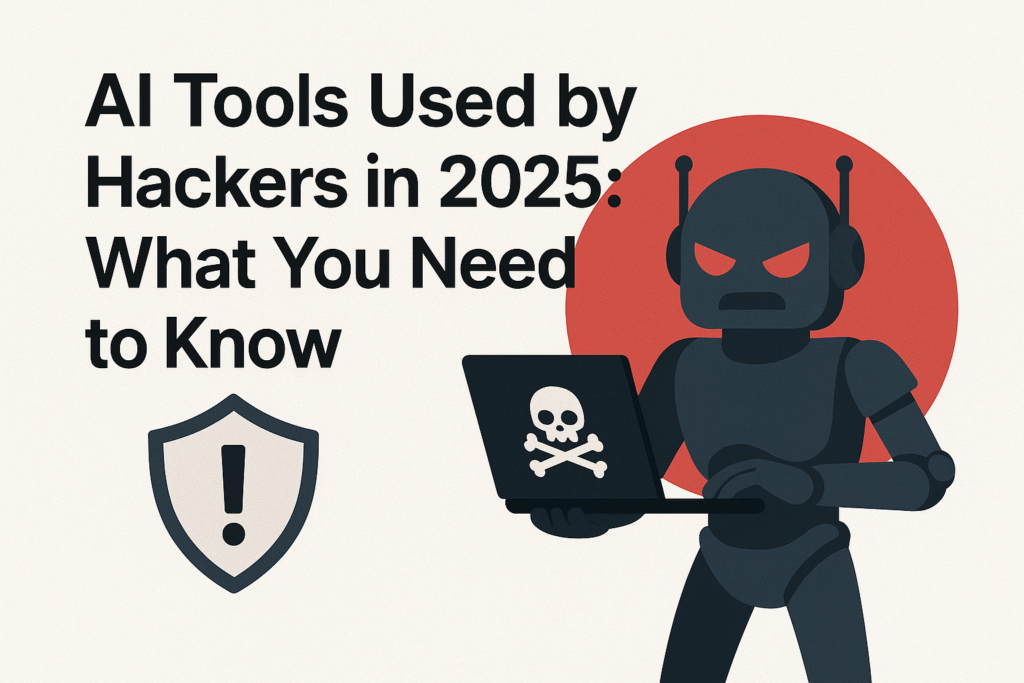
Table of Contents
AI tools used by hackers in 2025 have become more sophisticated than ever—posing serious risks for individuals, small businesses, and even major U.S. institutions. As artificial intelligence continues to evolve, so do the methods cybercriminals use to exploit it. From deepfake voice fraud to AI-generated phishing emails, the threat landscape has changed drastically.
In this post, we’ll break down the most common AI tools hackers are using in 2025, how they’re deployed, and—most importantly
Want visual version of this blog ?? check this out
🔐 Why Hackers Are Turning to AI in 2025
In 2025, cyberattacks are no longer just about brute force or malware. Artificial Intelligence allows hackers to automate attacks, personalize phishing scams, and even predict user behavior. With AI, a single hacker can launch attacks at the scale of an entire cybercrime ring—making it harder than ever to stop them.
According to the FBI’s Internet Crime Report 2025, over $14 billion in reported losses were linked to cybercrimes involving AI-powered tools. That’s up nearly 60% from 2024. (Source)
🤖 Top AI Tools Used by Hackers in 2025
Let’s explore the most common and dangerous AI tools used by hackers use today:
1. AI-Powered Phishing Generators
Hackers now use natural language models to generate hyper-realistic phishing emails and messages. These tools can:
- Personalize attacks using scraped data from LinkedIn and Facebook.
- Avoid spam filters by mimicking natural human tone.
- Translate phishing messages to multiple languages in seconds.
⚠️ *Tools like WormGPT and FraudGPT (underground variants of ChatGPT) are being actively sold on the dark web to craft phishing messages.
2. Deepfake Voice Cloning Software
Voice AI tools can now “mimic a person’s voice with just a few seconds of audio”. Scammers use this to:
- Trick family members into sending money.
- Impersonate CEOs or managers to request wire transfers.
- Bypass voice verification systems in banks.
Example: In early 2025, a “California-based fintech startup lost \$1.8 million” in a scam involving a cloned CEO’s voice on a Zoom call. [Read more]
3. AI Botnets for Automated Attacks
AI is used to power “botnets” that can:
- Launch automated brute-force attacks on login pages.
- Test thousands of username/password combinations in seconds.
- Use machine learning to adjust strategies mid-attack.
These AI-enhanced bots are often deployed in “ransomware attacks”, especially targeting small and medium U.S. businesses.
4. Synthetic Media and Deepfakes
Besides voice, hackers are using AI to **create fake videos and images**. They can:
* Fabricate incriminating content.
* Spread misinformation during elections.
* Impersonate trusted public figures.
Platforms like Deepware Scanner and Sensity AI can help you check the authenticity of videos and images.
5.AI-Based Vulnerability Scanners
Cybercriminals now use AI to scan websites and apps for vulnerabilities, including:
- Unpatched WordPress plugins.
- API endpoints leaking sensitive data.
- Misconfigured cloud servers.
These scanners use predictive algorithms to **find weak spots before you even know they exist.
How U.S. Hackers Are Deploying AI in Real Life
In 2025, cybercriminals in the U.S.aren’t just random teens in basements—they’re often part of organized digital crime networks. These groups use \*\*AI to:
- Automate identity theft.
- Harvest personal data from online leaks.
- Bypass CAPTCHA and biometric systems.
Example case: In April 2025, a Texas-based hospital network was attacked using AI to crack medical software credentials, resulting in the exposure of over 80,000 patient records.
How to Protect Yourself from AI-Driven Cyberattacks
With AI giving hackers an edge, here are proactive steps to defend yourself.
1. Use AI-Powered Defense Tools
Fight AI with AI. Use cybersecurity software that uses machine learning to detect abnormal behavior. Good options include:
2. Enable Multi-Factor Authentication (MFA)
Even if hackers guess your password using AI, **MFA can block them**. Use authentication apps like:
3. Educate Your Team
AI-generated phishing emails are tricky. Run regular **security awareness training**, and simulate phishing attacks with tools like:
4. Keep Software & Plugins Updated
Use automated patching tools and always update CMS platforms like WordPress. Outdated plugins are often the first thing AI vulnerability scanners target.
5. Monitor Your Digital Identity
Use dark web monitoring tools such as:
🧩 AI and Cybersecurity in 2025: A Double-Edged Sword
While we focus here on AI tools used by hackers in 2025, it’s worth noting that AI is also improving cybersecurity defenses. The same technology that’s being abused can be leveraged to detect fraud faster, spot anomalies, and block breaches before they spread.
🧠 Want to Learn How AI is Changing Cybersecurity?
If you’re interested in understanding how hackers use AI — and how to defend against it — consider taking a short cybersecurity course. With AI tools used by hackers in 20becoming more advanced, learning the fundamentals of AI in cybersecurity 2025 is more important than ever.Platforms like Udemy offer beginner to advanced courses on:
- Ethical hacking AI in cybersecurity
- Network security fundamentals
- Social engineering defense
🎓 Explore top-rated courses here:
👉 Cybersecurity Courses on Udemy
Affiliate Disclosure:
This link may earn a commission at no extra cost to you.
🧭 Conclusion: What You Need to Know About AI Tools Hackers Use in 2025
To sum it up, AI tools used by hackers in 2025 are transforming the threat landscape. From voice deepfakes and phishing generators to AI-powered botnets , these new weapons demand a smarter and more proactive defense.